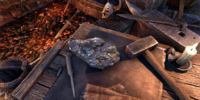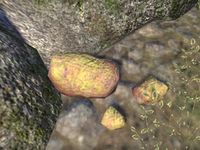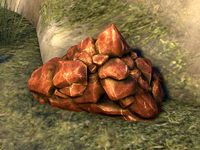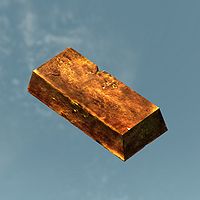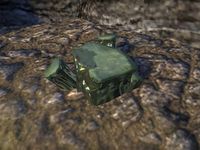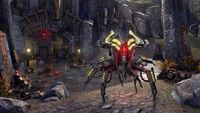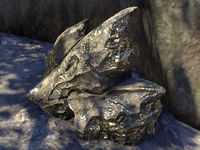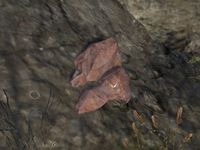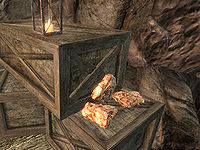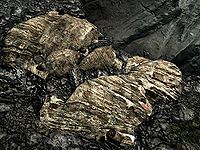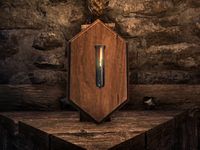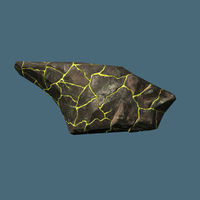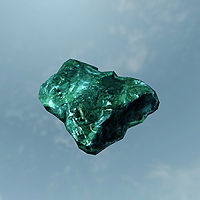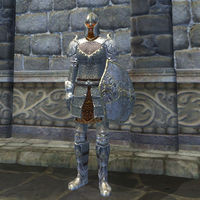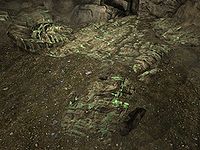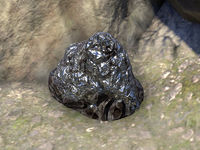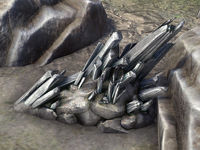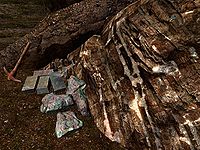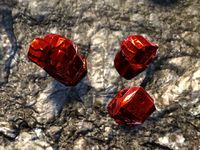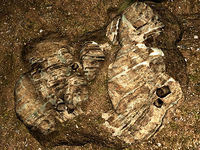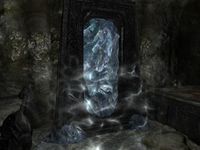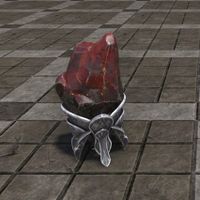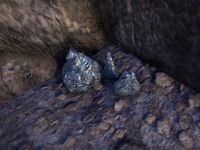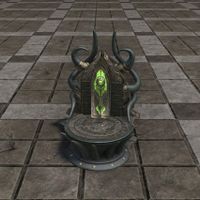Lore:Metals
Metals, alloys and ores are numerous in Tamriel and have been used by blacksmiths and craftsmen throughout history in a multitude of ways, ranging from construction, armor, weapons, decoration, household items and many more.
Adamantite[edit]
Adamantite was used by blacksmiths to forge arms and armor in the style of the Altmer during the mid-Second Era, and was widely available.[1][2]
Adamantium[edit]
Adamantium (also called Adamantine) is a rare and ageless metal used for making valuable armor and weapons. It is typically seen in a lustrous silvery color dubbed "Adamantine Silver", though during the Interregnum throughout Tamriel, equipment made from the material had a stone blue hue, while adamantium with a dark grey color was present throughout the Iliac Bay during the events leading up to the Warp in the West. The ore is very heavy and can be used in alchemy. Adamantium armor can appear as either a high-quality heavy weight armor or medium weight armor. It is above the quality of Mithril or Orichalcum, but is inferior to Stalhrim and Ebony. The armor has a high potential for enchantment. Adamantium weapons can harm magical creatures that resist normal weapons.
Antimony[edit]
Antimony was used in jewelry crafting during the mid-Second Era. Jewelry imbued with antimony granted the wearer increased vitality.[3]
Argentum[edit]
Argentum was used by blacksmiths to forge arms and armor in the style of Goblins and primal folk during the mid-Second Era.[4][5]
Arsenic[edit]
Arsenic is a metallic substance that has the poisonous properties of draining health and endurance.[6]
Brass[edit]
Brass is a brownish metal used by artisans and craftsmen throughout history in innumerable ways, ranging from jewelry, devices, decoration and household items.[7][8][9]
Brass was notably associated with the Numidium by way of its alias - the "Brass God", however its unknown if the Dwemer actually used the metal in its construction. Similarly, a piece of polished brass was used to represent Numidium in the construction of the Staff of Towers.[10] Brass was also widely used in the creations of Sotha Sil, such as the Clockwork City, factotums, and fabricants. Its alchemical properties can be used to enhance agility.[11]
Tempered brass was used by blacksmiths to forge arms and armor in the style of Clockwork Apostles during the mid-Second Era.[12][13]
Bronze[edit]
Bronze is a soft brownish alloy consisting primarily of copper and tin.[14] It has been used by blacksmiths and craftsmen throughout history in innumerable ways, ranging from jewelry, armor, weapons, decoration and household items.[15][16] Bronze is said to easily mistaken for Dwarven Metal, so much so that some craftsmen have been known to create fake replicas of Dwemer arms and armor using the metal.[17]
The usage of bronze among the armies of various races is notable, particularly in the First Era. In the early days of King Harald's reign, steel was limited, so bronze plate armor made up the bulk of his army's cuirasses.[18] Similarly, bronze metal featured heavily in ancient Orcish breastplates.[19] Bronze was also used extensively by the ancient pre-Duskfall Argonians tribes in the forging of their arms and armor.[20] During the mid-Second Era, it was used by blacksmiths to forge arms and armor in the style of Reachmen clans.[21][22]
Bronze is also used widely in the art of bronzing, whereby a layer of bronze is applied to a surface, giving it a bronze finish. Notable examples include the Clockwork Apostles, who sometimes observe a tradition where they bronze their amputated body parts after replacement.[23]
Teeth are sometimes bronzed, particularly in Breton culture where the teeth of young children are bronzed and saved as a remembrance.[24][25]. Other times, the teeth of daedroth are bronzed and crafted into items, such as hairpins.[26]
Calcinium[edit]
Calcinium was used by blacksmiths to forge of arms and armor during the mid-Second Era. Calcinium was smelted from reddish-golden ore deposits that could be found almost anywhere during this time period.[27]
Cassiterite[edit]
Cassiterite was used by blacksmiths to forge arms and armor in the style of the ancient Orcs during the mid-Second Era. Mined cassiterite takes the form of grey sand, which could be found throughout Wrothgar during this time period.[28][29]
Chromium[edit]
Chromium was a golden metal used in jewelry crafting during the mid-Second Era. Raw chromium takes the form of grains, that when refined would produce platings that could be used to fortify pieces of jewelry.[30]
Cobalt[edit]
Cobalt was used in jewelry crafting during the mid-Second Era. Jewelry imbued with cobalt granted the wearer increased magicka.[31]
Copper[edit]
Copper is a dark orange metal used by various artisans and craftsmen. During the mid-Second Era copper seams were commonly found near cliffs and mountains across Tamriel.[32] Mined copper can be ground into dust and refined into small ingots that can be used to create jewelry,[33] household items or tools.[34] Blacksmiths have also been known to use copper as accents or decorations when creating arms and armor.[22][35]. Its alchemical properties can be used to detect magic.[36][37]
Its earliest know usage dates back to the Merethic Era, when ancient Nordic and Dwemer civilizations used copper in various crafts.[38][39] Copper was used prominently throughout the Clockwork City, from copper wiring found inside in Brassilisks[40][41] to the artificial trees and shrubs that dot the land.[42][43]
Corundum[edit]
Corundum is a dark orange metal used by blacksmiths and craftsmen. A freshly exposed surface of corundum had a yellowish-orange color and when extracted produced corundum ore. This ore could further be smelted into ingots, or combined with iron ore to create steel.[44]
Corundum was used by blacksmiths to forge arms and armor in the Nordic style during the mid-Second Era, and was widely available.[45][46] Steel plate armor can be made by adding iron to molten corundum. The resulting alloy is stronger than either metal by itself. Corundum is said to be a finicky material, requiring the heat from the forge to be steady and not vary much.[47]
Corundum was relatively common throughout Skyrim in the early Fourth Era, and the province was home to several corundum mines.[48]
Dibellium[edit]
Dibellium was used in jewelry crafting during the mid-Second Era.[31]
Dwarven Adamant[edit]
Dwarven Adamant, also known as Adamant, is a white-hued alloy of ores of unknown origin, believed to be the most durable material ever made. It is among the rarest materials on Nirn.
The Dwemer used adamant, along with other materials, such as ebony, vitrine, and dwarven metal, for constructing certain vamidiums.
Dwarven Metal[edit]
Dwarven Metal refers to heavy, exotic metals used primarily by the Dwemer. It is usually copper in color, although it can also be yellow, grey, or green. The Dwemer used the metal extensively, from architecture to cutlery, most notably for Dwemer Animunculi. To the other races of Tamriel, it is primarily of interest for use in smithing weapons and armor.
Dwarven weapons are prized for their ability to resist corrosion and retain their edge, while Dwarven armor has distinctive impact-absorbing qualities. For this reason, Dwemer artifacts are highly prized by adventurers and collectors. The metal itself is rare and precious, scraps of which are prized both by collectors of antiquities and students of metals and enchantments. Only the most skilled blacksmiths have the ability to emulate ornate Dwarven craftsmanship, although the metal is often incorporated into cultural designs. True Dwarven metal was made using an unknown process that many metallurgists have tried to replicate unsuccessfully. The only way to obtain the metal is to melt down existing Dwemer items made from the substance. The Dwarves required the intense heat of molten lava to forge this metal.
Dwarven Ore[edit]
Dwarven Ore is a naturally occurring ore deposit that could be found across Tamriel during the Second Era. Dwarven Ore acquired its name due to the visual resemblance it bears to Dwarven Metal when forged; however, it lacks the metal's durability, and metallurgists have concluded that it has no connection to the metal harvested from actual Dwemer devices.
Ebony-steel[edit]
Ebony-steel, also known as Ebon Steel, and Ebonsteel is an alloy. It is unknown if this alloy actually contained Ebony and Steel or has been simply named as such, but it was a dark, durable substance.
It was used by the Dwemer, along with other materials, such as adamant, ebony, vitrine, and dwarven metal, for constructing certain vamidiums.
Ebony-steel was also used by the knights all across Tamriel, and by the soldiers of the First Aldmeri Dominion. Maces made of the ebony-steel had a tripartite head of three heavy eagle's wings: one for each of the races of the alliance: Altmer, Khajiit, and Bosmer.
Electrum[edit]
Electrum was used in jewelry crafting during the mid-Second Era. Silver electrum deposits were commonly found near cliffs and mountains across Tamriel during this time period.[32] Mined electrum can be ground into dust and refined into small ingots that can be used to create jewelry.[49]
Foscarium[edit]
Foscarium is a metal with some resemblance to gold, but seemingly worth less than gold. Due to this resemblance, foscarium has been illegally distributed by smugglers as counterfeit currency.[50]
Frog-Metal[edit]
Frog-Metal (also called Buoyant Steel or Syrabane's Steel) is a rare and highly valued alchemical alloy first discovered by Syrabane, the Aldmeri ancestor-god of magic in the mid-First Era. As one of its names suggests, the metal is incredibly light, so much so that it can float in water. Seafarers and warriors of the Abecean Sea often wore frog-metal armor to ride the waves fearlessly, but over time it was nigh extinct. It was particularly valued by those from Amenos, an island in the Systres Archipelago.
Galatite[edit]
Galatite was used by blacksmiths to forge of arms and armor during the mid-Second Era. Galatite was smelted from pinkish ore deposits that could be found almost anywhere during this time period.[51] It was used to craft manacles by the Altmer.[52]
Gloamium[edit]
Gloamium is a metal from Nocturnal's realm of Evergloam noted for possessing odd properties. Although it looks like silver and melts like iron, gloamium does not act like either of those metals. Instead, it remains cold to the touch, and will not warm even when placed next to flame. In 2E 367, a watchman in Alinor accidentally embedded a fleck of gloamium in his eye; according to reports, he would lose his sight during the day, but could see perfectly well at night. The Gray Cowl of Nocturnal was made using rivets forged from gloamium.[53]
Gold[edit]
- For the currency, see Currency § Gold.
Gold is a valuable metal predominantly minted into coins by the Empire to be used as currency by the whole of Tamriel. It is also sometimes used in jewelry and armors. Its alchemical properties can be used to charm individuals.[54]
Iridium[edit]
Iridium was a blue metal used in jewelry crafting during the mid-Second Era. Raw iridium takes the form of grains, that when refined would produce platings that could be used to fortify pieces of jewelry.[55]
Iron[edit]
Iron is the most commonly used metal in Tamriel. It is dark grey in color, and has a wide range of uses in blacksmithing. Its abundance makes the metal ideal for creating mundane items like nails or containers. Weapons and armor made from iron are easy to produce, but vastly inferior to equipment made from most other metals. Iron can be converted to steel, either through refinement of high-quality ore or through the creation of an alloy when combined with corundum. It can also be used in alchemy to produce a slowfall effect or magically transmuted into silver.
Lead[edit]
Lead is a metal used primarily in alchemy. Its properties can be used to fall from great heights at a slower rate.[56]
Liquid Silver[edit]
Liquid Silver is a rare, heavy, viscous metal often thought to have healing or life-prolonging properties. It is also believed to have a severely adverse effect on werewolves and so crossbow bolts infused with liquid silver are highly prized by groups such as the Fighters Guild.[57]
Lodestone[edit]
Lodestones are metals with strong magnetic energy. They can attract dust, debris, and metals like iron. They are commonly used for navigation. Generally, they are made into compasses for sea travel. Lodestones can also manipulate electricity and its associated magic. The Maormer, who often travel the sea and use storm magic, use lodestones for several functions. But lodestones can also have magical properties. Enchanted lodestones can focus magicka over a distance and usually come in pairs to form sympathetic links between them. They can also be focused for navigation spells and through the links, trace each other's location. Lodestones are also used in alchemy and can enhance one's jumping abilities.
Madness Ore[edit]
Madness Ore (often shortened to madness) is a flexible, dark black or brown metal marbled with glowing gold veins, which can be found in the Shivering Isles. Deposits occur naturally in ancient ruins left behind by previous Greymarches, where the spirits of ancient souls and the tattered minds of dead heroes become trapped in the ore. Madness ore smithing is an ancient art of the mortal inhabitants of the realm. The master smith of Crucible has the ability to make heavy madness weapons and armor. Before the master dies, he will hide matrices throughout the realm and train an apprentice to continue the tradition. Grummites are known to occupy places such as abandoned subterranean halls where Madness Ore is commonly found, due to their strange attraction towards the material; indeed, they are known to collect shards of the ore.
Malachite[edit]
Malachite, commonly known as glass (and not to be confused with common glass), is a rare, volcanic, milky translucent green crystal that absorbs magicka under the right conditions. It is most often used in creating strong, yet lightweight metallic armor and weapons. The material is similar to ebony, but is less durable and more lightweight. It bears no relation to the common, brittle glass used in windows and ornaments, as it is far stronger and has a much higher melting point. It is most commonly found in Morrowind on the volcanic island of Vvardenfell, but ore veins can also be found all across Tamriel.
Manganese[edit]
Manganese was used by blacksmiths to forge arms and armor in the style of the Orcs during the mid-Second Era, and was widely available.[58][59]
Mercury[edit]
Mercury is a metal used primarily in alchemy. Its properties can be used to increase speed.[60]
Meteoric Iron[edit]
Meteoric Iron is a variety of Aetherial Fragment. It is the most common fragment to fall to Nirn. All known samples of the metal are a rusty brown in color. It is prized by armorers and enchanters for its properties in the forging of enchanted weapons and armors. The Ayleids, known for harnessing Aetherial Fragments, incorporated the metal into their architecture. As such, it is a common sight in Ayleid ruins. Meteoric Iron is resistant to most elements, and it's believed to have been used by the Akaviri Dragonguard to forge bulwarks against the Dragons' elemental breath.
Mithril[edit]
Mithril (sometimes spelled Mythril) is an elusive and relatively scarce metallic material, known for being light and rather valuable, likely due to its rarity. It comes in two different colors; in places such as Cyrodiil it comes in a shiny silver color, while in the provinces of Hammerfell and High Rock, it is seen in navy-blue. When broken, it can easily be melded together when heated up, unlike chainmail. The only known veins of mithril can be found in the Dragon's Teeth Mountains, where the Kragen Clan harvested the material as one of their main resources, but whether it has been exhausted is unknown. There is another variant of mithril called Elvish Mithril.
Molybdenum[edit]
Molybdenum was used by blacksmiths to forge arms and armor in the style of the Bretons during the mid-Second Era, and was widely available.[61][62]
Moonstone[edit]
Moonstone is an ivory colored metal found in veins throughout Tamriel. It is generally used, sometimes in tandem with quicksilver to make elven armor, the construction of which was held for a long time by the Altmer of Summerset as a closely-guarded secret. Moonstone is also the signature material used in Khajiiti-styled armor. Moonstone melts at a much higher heat than quicksilver, making it tricky to work with both of them together. Saltwater is required to quench the hot metal when making elven armor.
Nickel[edit]
Nickel was used by blacksmiths to forge arms and armor in the style of the Imperials during the mid-Second Era, and was widely available.[63][64]
Orgnium[edit]
Orgnium is a mysterious metal used by the Maormer of Pyandonea. Easily recognizable for its light weight and teal color, it is used extensively in their heavier weapons and armor; notable examples of which include cuirasses and shoulder armor.
Orichalcum[edit]
Orichalcum (also called Orichalc) is a grayish-green metal used primarily to make weapons and armor. Orcs are famed for their use of this metal, with some comparing its qualities to the Orcs themselves - green, exceptionally rigid, stronger than steel, and extremely temperamental.
Palladium[edit]
Palladium was used by blacksmiths to forge arms and armor in the style of the Ayleids during the mid-Second Era.[65][66]
Pewter[edit]
Pewter was used in jewelry crafting during the mid-Second Era. Pewter deposits were commonly found near cliffs and mountains across Tamriel during this time period.[32] Mined pewter can be ground into dust and refined into small ingots that can be used to create jewelry.[67] Nighthollow Clan was known to use pewter filigree to decorate their armors.[68]
Platinum[edit]
Platinum was used in jewelry crafting during the mid-Second Era. Platinum deposits were commonly found near cliffs and mountains across Tamriel during this time period.[32] Mined platinum can be ground into dust and refined into small ingots that can be used to create jewelry.[69]
Pyrite[edit]
Pyrite, also known as fool's gold is a mineral known for its resemblance to gold.
Pyrite was utilized in Dunmeri ritualistic crafting, with firestrikers made from pyrite and flint adorned with imagery depicting Saint Vorys the Immolant.
The phrase "fool's gold" was frequently employed across Tamriel as a metaphor to characterize something that seemed valuable but ultimately proved to be worthless.
Quicksilver[edit]
Quicksilver is a silver metal used by blacksmiths and craftsmen. A freshly exposed surface of quicksilver had a blueish-white color and when extracted produced quicksilver ore. This ore could further be smelted into ingots. During the mid-Second Era, quicksilver ore deposits could be found almost anywhere in Tamriel. Quicksilver was relatively rare throughout Skyrim in the early Fourth Era, and the province was home to only one quicksilver mine.
Quicksilver is used by blacksmiths to forge various arms and armor. It melts at a much lower heat than Moonstone, but with some skill can be mixed with it to forge Elven arms and armor. Similarly, it can be mixed with Ebony and Steel to forge Nordic arms and armor. Quicksilver armor and weapons vary in strength. During the mid-Second Era, blacksmiths managed to make it surpass the likes of ebony in quality. This is due to the Guild Act which allowed for a greater diffusion of knowledge about exotic materials. The Mages Guild in particular are credited for learning how to refine such magical ores as a result. However, by the Fourth Era, the norm was that quicksilver armor was slightly weaker than that made of Chaurus chitin.
Rubedite[edit]
Rubedite is a red rare high-quality metal used by blacksmiths to forge of arms and armor exceeding ebony in quality, which is smelted from shiny dark red ore deposits.[nb 1] The origins of who first worked with rubedite is unknown, but by crafting enchanted armor with metalworking tools blessed by Akatosh and Zenithar, coating said armor with a rubedite metal enamel, and then tempering it with captured dragonflame, paladins from Daggerfall were able to create their set of rubedite armor sometime after Ranser's War.
Rubedite left obscurity around the time the Three Banners War spilled into the Imperial City, when it along with other equipment created out of high-quality materials were recovered as spoils of war. Vendors from the three alliances exchanged rubedite alongside rubedo leather, ruby ash, and ancestor silk for the Tel Var Stones soldiers looted during their campaign, and master artisans of the various crafting professions broke down the materials to use for their needs.[nb 1] Rubedite has also been used to create mortars and pestles used specifically for grinding scrib leg joints for the Dunmeri funerary practices. Tendrils of tomeshells leather adorned with rubedite beads at their tips have been used by people as a hair accessories. Masters of Tales of Tribute tournaments were rewarded with trophies made of orichalcum, ebony, quicksilver, voidsteel, and rubedite, with rubedite being the most prestigious and orichalcum being the least. Rubedite is rumored to have been used to commemorate 95 years of reign of a ruler from a kingdom bordering Bloodfall Kingdom.
Singersteel[edit]
Singersteel is a rare alloy composed of nine parts steel and one part orichalcum. Its origins are unclear, but some scholars speculate the Lefthanded Elves obtained orichalcum during their war with the Yokudans and used it to form an alloy to create their own arms and armor.[70]
Silver[edit]
Silver, also known as "moon-kissed ore" by the Reachfolk,[71] was a precious metal used by blacksmiths, craftsmen and jewelers throughout history in innumerable ways.
A freshly exposed surface of silver had a greyish white color and when extracted produced silver ore. This ore could further be smelted into ingots.[72] Mined silver could also be ground into dust and refined into smaller ingots that were used to create jewelry.[73] It is said working with silver requires more skill compared to iron or steel.[74]
Orgnum is credited in some legends with being the first person to work silver.[75] During the mid-Second Era silver deposits were commonly found near cliffs and mountains across Tamriel.[32] The Nordic city of Markarth is famed for its silver mines, particularly in the early Fourth Era where it was said to have been the source of half the silver in Skyrim.[76][77] There is enchanted silver ore located in the depths of Bthar-Zel that is commonly used by the Reach clans. It was particularly potent against the Gray Host.[78]
Silver weapons are said to be especially effective against Lycanthropes, vampires, and the undead.[79][80] As such, silver arms and armor were used extensively by groups of werewolf hunters, namely the Order of the Silver Dawn and the Silver Hand.[81][82] In other cases, weapons were sometimes plated or filigreed with silver to achieve similar effects.[83] Silver's alchemical properties can be used to cure magic.[84]
There is another type of silver called Argonian Silver.[85]
Sphalerite[edit]
Sphalerite was used by blacksmiths to forge arms and armor in the style of the Militant Ordinators.[86]
Stalhrim[edit]
Stalhrim is a rare form of enchanted ice found only on the island on Solstheim. Throughout history it has served various uses. Originally it was used in the burial rituals of ancient Nords. The deceased would be encased in the material as a form of protection, a privilege that was typically reserved for Nordic individuals. It has also served as a crafting material and, with the proper tools and techniques, can be used to create weapons, armor, clothing, and even jewelry.
Stalhrim armor (sometimes called ice armor) can be light, medium, or heavy in weight. It is very protective, and is often made with steel or quicksilver. Due to its innate properties, frost enchantments placed on items made of stalhrim are more potent. In its raw form, it can be used as an alchemical ingredient that induces paralysis and inflicts frost damage.
Stalhrim is often described as being hard as iron and impossible to break by conventional means. The only known way to mine it is with an ancient Nordic pickaxe, made from superior craftsmanship. It has been described as a rigid, blue-white crystalline metal, faceted yet smooth, and unnaturally cold to touch. Working with stalhrim is much like ebony smithing, and can only be performed by a skilled blacksmith.
Starmetal[edit]
Starmetal was used by blacksmiths to forge arms and armor in the style of the Redguards during the mid-Second Era, and was widely available.[87][88]
Steel[edit]
Steel is a silver alloy consisting primarily of iron and corundum.[89] It can also be created by refining from a light orange ore known as High Iron.[90] It has been used by blacksmiths and craftsmen throughout history in numerous ways, ranging from armor, weapons, decoration and household items.[91][92] It is said working with steel requires less skill compared to silver.[74][47]
Steel has been used by many races in Tamriel since ancient times. The Nords of the Merethic Era used steel to forge much of their arms and armors, many of which survived into the Fourth Era.[93] During the early days of King Harald's reign, steel was limited in supply, so bronze plate armor made up the bulk of his army's cuirasses.[18]
The Dwemer were believed to use a rare alloy know as Ebon Steel to create certain vamidium[94][95], and weaponry.[96] However it is unknown if this alloy actually contained steel or has been simply named as such.
The Yokudans of the First Era were masters of metalcrafting and used precise steel forging techniques to create their famed swords. Low-carbon steel was used to form the core of their swords, then high-carbon steel used to form the skin of the sword.[97] They were also known to record much of their knowledge in tomes of steel plates, such as the Cartulary of the Tamed Dunes.[98]
During the mid-Second Era, the Aldmeri Dominion were known to use a supple alloy known as Lillandril Steel in their bow crafting. This form of steel was said to be as durable as it was ductile, allowing them the create slender yet powerful bows.[99]
Xivilian Steel is known to be traded in Fargrave and the Deadlands.[100]
Steel weapons and armor are standard issue for the Imperial Legion. Because steel is inexpensive, heavy steel plate armor and steel shortswords are made in large quantities and many are trained in its use.[83][101]
Accoring to Nordic blacksmiths, the most superior steel in all of Tamriel is that which is produced at the Skyforge. Skyforge Steel maintains a near-mythical reputation in Skyrim, where many believe the souls of ancient Nordic heroes are what give Skyforge Steel its strength.[102][103][104]
Terne[edit]
Terne was a greenish metal used in jewelry crafting during the mid-Second Era. Raw terne takes the form of grains, that when refined would produce platings that could be used to fortify pieces of jewelry.[105]
Tin[edit]
Tin is a soft, silvery-colored metal. It is used to make tin cans, toys, and other utensils.[106][107] Tin is also used in alchemy and possesses modest magical effects.[108] The Guild Act of 2E 321 established the Tinkers Guild as a pan-Tamrielic Imperial guild for itinerant tinsmiths.[109] The Barkbite Clan of Wood Orcs possessed a tin mine at Reman's Bluff, although their smiths found it to be a fussy metal to work with.[110]
Titanium[edit]
Titanium was used in jewelry crafting during the mid-Second Era. During this time period, titanium deposits were commonly found near cliffs and mountains across Tamriel. Jewelry imbued with titanium granted the wearer more protection.[111]
Tyranite Calx[edit]
Tyranite Calx is an interstitial alloy used in the production of Dark Anchors, infused with soul gem fragments and other trace components. Sondivel experimented with the metal using a soul magic ritual to shape it into malleable bands that could weaken the will of the wearer.
Voidstone[edit]
Voidstone was used by blacksmiths to forge of arms and armor during the mid-Second Era. Voidstone was smelted from dark purple ore deposits that could be found almost anywhere during this time period.[112] It was used by Daedric craftsmen to craft rivets which were components of Spaulder of Ruin.[113] Refined voidstone is referred to as the voidsteel.[114][115] Establishment of pan-Tamrielic guilds resulted in greater diffusion of knowledge. Smiths learned of interesting materials, such as voidsteel, used only in distant lands, and this drove demand and trade for those materials.[116]
Wispmetal[edit]
Wispmetal is a rare metal from Apocrypha. It is sometimes quenched in tomeshell gore when being forged.[117]
Zinc[edit]
Zinc was used in jewelry crafting during the mid-Second Era. Jewelry imbued with zinc granted the wearer increased stamina.[118]
Zircon[edit]
Zircon was a metal used in jewelry crafting during the mid-Second Era. Raw zircon takes the form of grains, that when refined would produce platings that could be used to fortify pieces of jewelry.[119]
References[edit]
- ^ Adamantite in ESO
- ^ Crafting Motif 1: High Elf Style — Doctor Alfidia Lupus
- ^ Antimony in ESO
- ^ Argentum in ESO
- ^ Crafting Motif 13: Primal Style — Seif-ij Hidja
- ^ Spell/poison indices in Daggerfall
- ^ Brass Navigator's Quadrant contraband item in ESO
- ^ Jaqspur Captain's Arboreal Spotting Scope contraband item in ESO
- ^ Brass Oil Lamp contraband item in ESO
- ^ Walk-Brass Staff Fragment quest item in ESO
- ^ Brass ingredient in Daggerfall
- ^ Tempered Brass in ESO
- ^ Crafting Motif 56: Apostle Style — Artificer Dalomar
- ^ Enthoras' Journal
- ^ Commemorative "Broken Shackles" Medal contraband item in ESO
- ^ Heavy Bronze Nose-Ring contraband item in ESO
- ^ Dwarves, v1 — Calcelmo, Scholar of Markarth
- ^ a b Crafting Motif 87: Ancestral Nord Style — Bjarnus Whitewhiskers
- ^ Crafting Motif 88: Ancestral Orc Style — Armelle Menant, Historian of Glenumbra
- ^ Crafting Motif 70: Elder Argonian Style — Concordia Mercius
- ^ Bronze in ESO
- ^ a b Crafting Motif 12: Barbaric Style — Seif-ij Hidja
- ^ Bronzed Apostle Hand contraband item in ESO
- ^ Bronzed Baby Teeth contraband item in ESO
- ^ Bronzed Egg Tooth contraband item in ESO
- ^ Bronzed Daedroth Teeth Hairpins contraband item in ESO
- ^ Calcinium Ore in ESO
- ^ Cassiterite in ESO
- ^ Crafting Motif 21: Ancient Orc Style — Curator Umutha of the House of Orsimer Glories
- ^ Chromium Plating in ESO
- ^ a b Cobalt in ESO
- ^ a b c d e Events of ESO
- ^ Copper and Onyx Circlet item in Skyrim
- ^ Copper Spice Grinder contraband item in ESO
- ^ The Improved Emperor's Guide to Tamriel: Black Marsh — Flaccus Terentius, 2E 581
- ^ Copper ingredient in Daggerfall
- ^ Music Box, Blessings of Stone's antiquity codex entries in ESO: Firesong
- ^ Copper Dragon Claw contraband item in ESO
- ^ Dwarven Compass contraband item in ESO
- ^ The Fabricated Fauna of Clockwork — Endilaril, Naturalist
- ^ Brassilisk description in ESO
- ^ Fabricant Shrub, Copper item in ESO
- ^ Artificial Lodestone Parts item in ESO
- ^ Corundum Ore in Skyrim
- ^ Crafting Motif 4: Nord Style — Doctor Alfidia Lupus
- ^ Corundum in ESO
- ^ a b Heavy Armor Forging — Sven Two-Hammers
- ^ Events of Skyrim
- ^ Electrum in ESO
- ^ Counterfeit Gold quest in Daggerfall
- ^ Galatite Ore in ESO
- ^ Galatite Manacles item description in ESO
- ^ The Shadow Queen's Cowl Gloamium Rivets Antiquity Codex in ESO
- ^ Gold ingredient in Daggerfall
- ^ Iridium Plating in ESO
- ^ Lead ingredient in Daggerfall
- ^ Liquid Silver
- ^ Manganese in ESO
- ^ Crafting Motif 8: Orc Style — Doctor Alfidia Lupus
- ^ Mercury ingredient in Daggerfall
- ^ Molybdenum in ESO
- ^ Crafting Motif 5: Breton Style — Doctor Alfidia Lupus
- ^ Nickel in ESO
- ^ Crafting Motif 10: Imperial Style — Doctor Alfidia Lupus
- ^ Palladium in ESO
- ^ Crafting Motif 11: Ancient Elf Style — Seif-ij Hidja
- ^ Pewter in ESO
- ^ Crafting Motif 95: Nighthollow Style — Lord Idrisin, Bearer of the Scarlet Insignia
- ^ Platinum in ESO
- ^ Lefthander's Aegis Belt codex entry
- ^ Chief Ulvfae's dialogue in ESO: Markarth
- ^ Silver in Skyrim
- ^ Silver in ESO
- ^ a b Endon's dialogue in Skyrim
- ^ Sea Silver Chain in ESO
- ^ Thonar Silver-Blood's dialogue in Skyrim
- ^ The City of Stone — Amanda Alleia
- ^ Ardanir's dialogue in ESO: Markarth
- ^ Dealing with Werewolves — Venustinius Perquitienus
- ^ Arana's dialogue during Blood of the Reach in ESO: Markarth
- ^ Silver Hand in Skyrim
- ^ Purifier's Journal — Purifier Cyrus
- ^ a b Garothmuk gro-Muzgub's dialogue in Morrowind
- ^ Silver ingredient in Daggerfall
- ^ Elden Grove riddle in Arena
- ^ Militant Ordinator Style in ESO: Morrowind
- ^ Starmetal in ESO
- ^ Crafting Motif 6: Redguard Style — Doctor Alfidia Lupus
- ^ Steel in Skyrim
- ^ High Iron Ore in ESO
- ^ Steel Lantern contraband item in ESO
- ^ Engraved Stein contraband item in ESO
- ^ Ancient Nord Weapons in Skyrim
- ^ Ebon Dwarven Senche mount description in ESO
- ^ Ebon Steel Dwarven Spider mount description in ESO
- ^ Appearance of Dwarven Black Bow of Fate in Skyrim
- ^ The Book of Circles: Forging Maxims — Frandar Hunding
- ^ Cartulary of the Tamed Dunes item in ESO
- ^ Crafting Motif 25: Aldmeri Dominion Style — Aicantar of Shimmerene, Sapiarch of Indoctrination
- ^ Rayna Falas' dialogue in ESO
- ^ Flaenia Amiulusus' dialogue in Morrowind
- ^ Eorlund Gray-Mane's dialogue in Skyrim
- ^ Oengul War-Anvil 's dialogue in Skyrim
- ^ Nords of Skyrim — Hrothmund Wolf-Heart
- ^ Terne Plating in ESO
- ^ Musty Bait Tin in ESO
- ^ Tin Row Boat in ESO
- ^ Tin in Daggerfall
- ^ History of the Fighters Guild
- ^ Shakul's dialogue in ESO
- ^ Titanium in ESO
- ^ Voidstone Ore in ESO
- ^ Spaulder of Ruin antiquity codex entry in ESO
- ^ Voidsteel Weapons in ESO
- ^ Voidsteel Armor in ESO
- ^ Master Assistant Materials Acquirer Pacrooti Answers Your Questions — Pacrooti
- ^ Music Box, Glyphic Secrets Antiquity Codex in ESO
- ^ Zinc in ESO
- ^ Zircon in ESO
